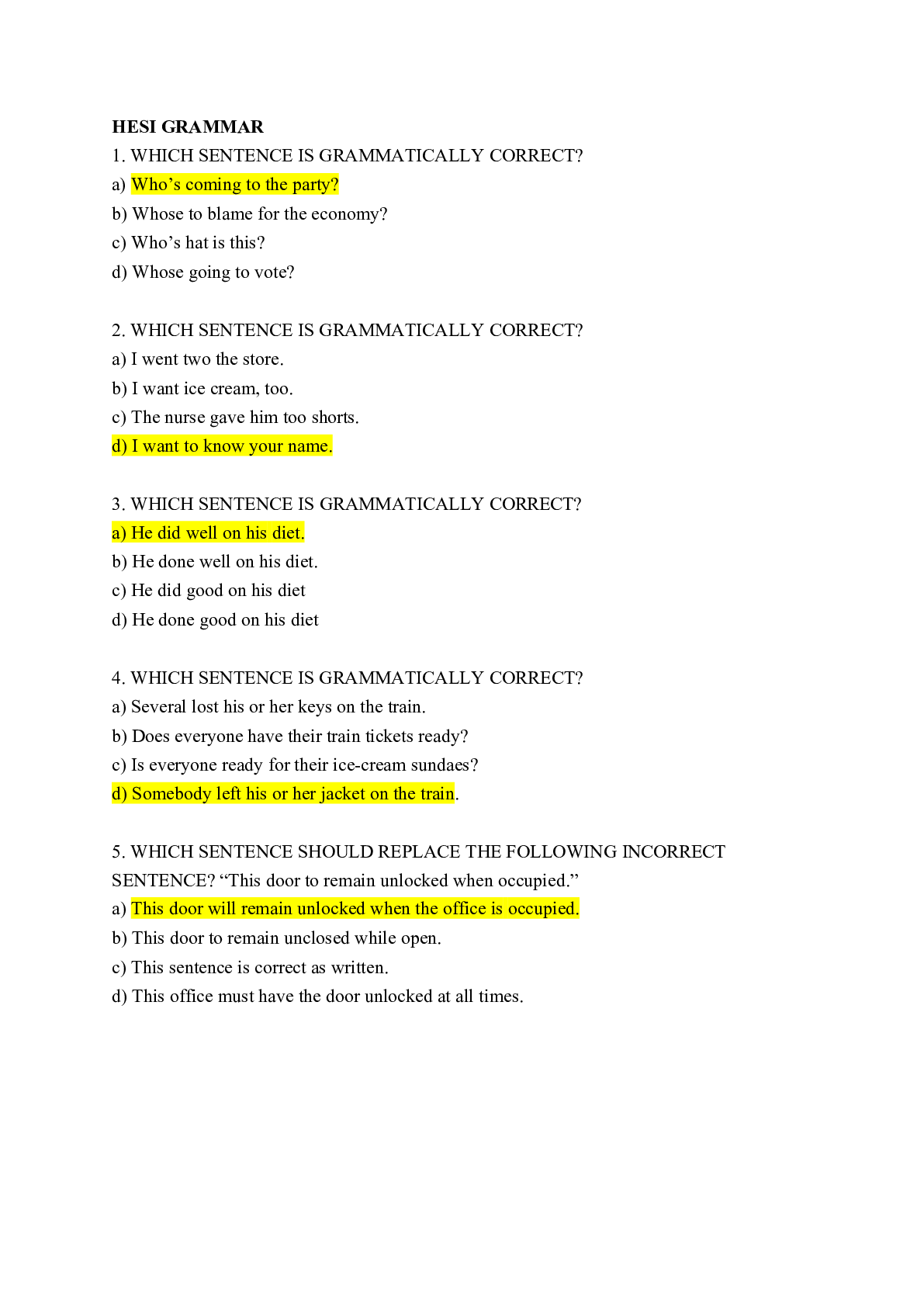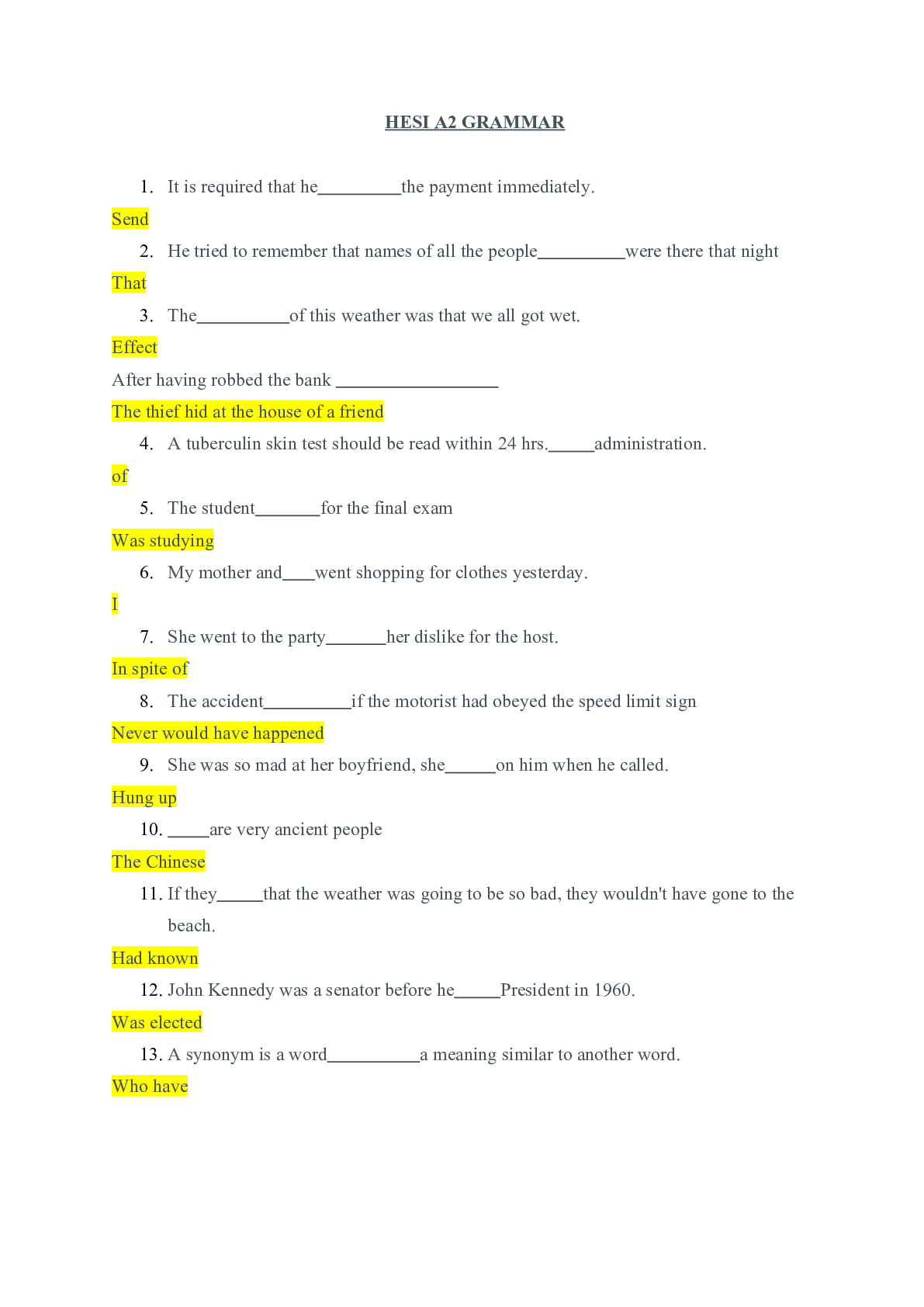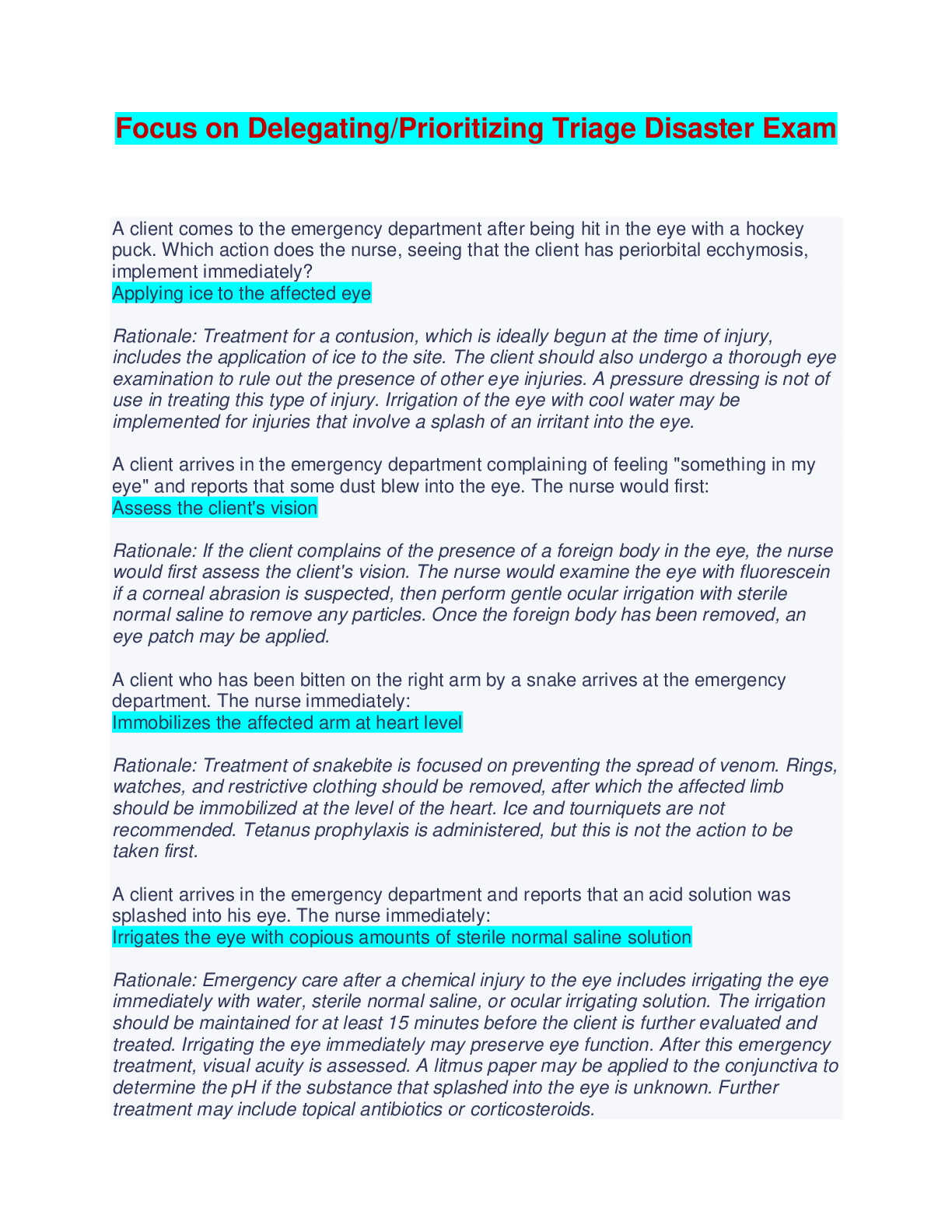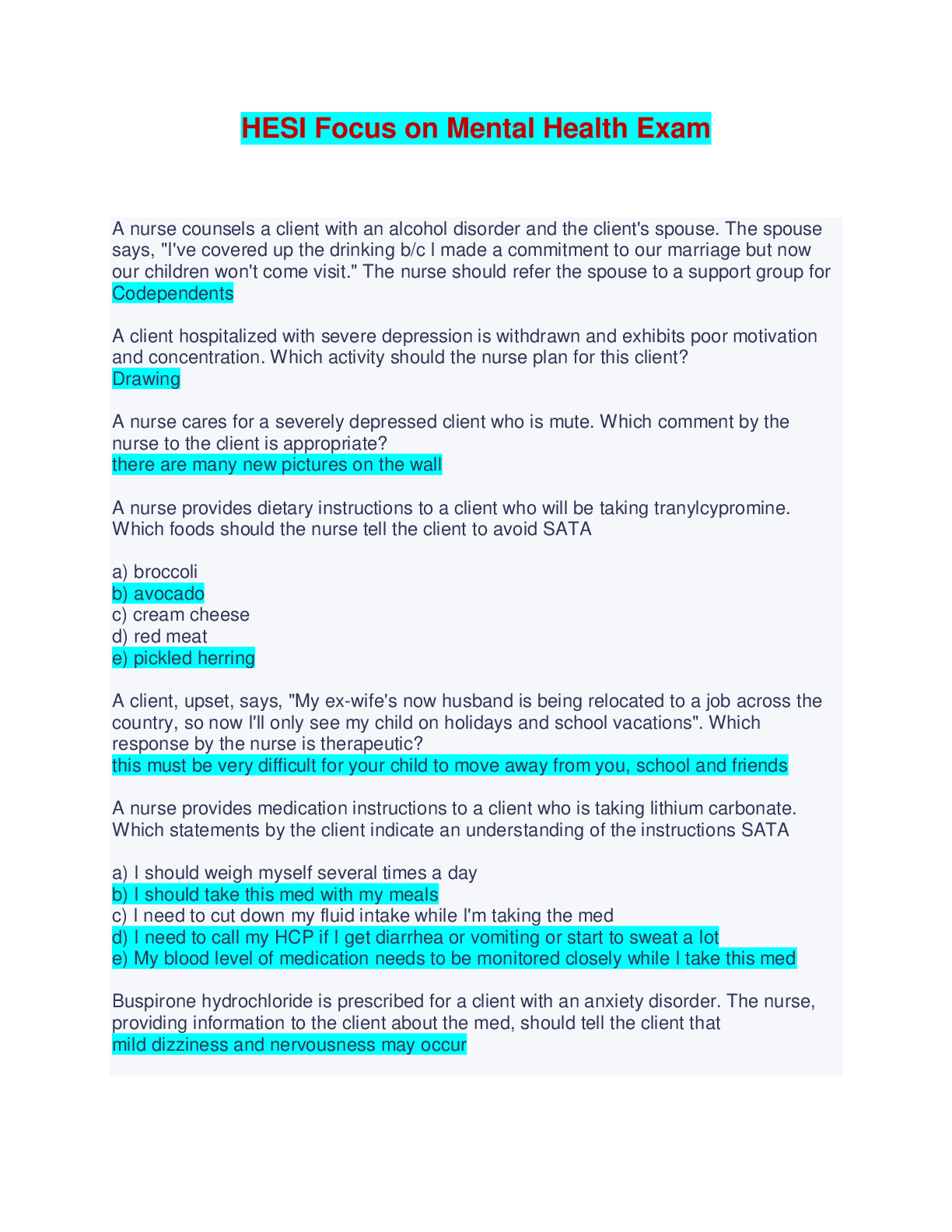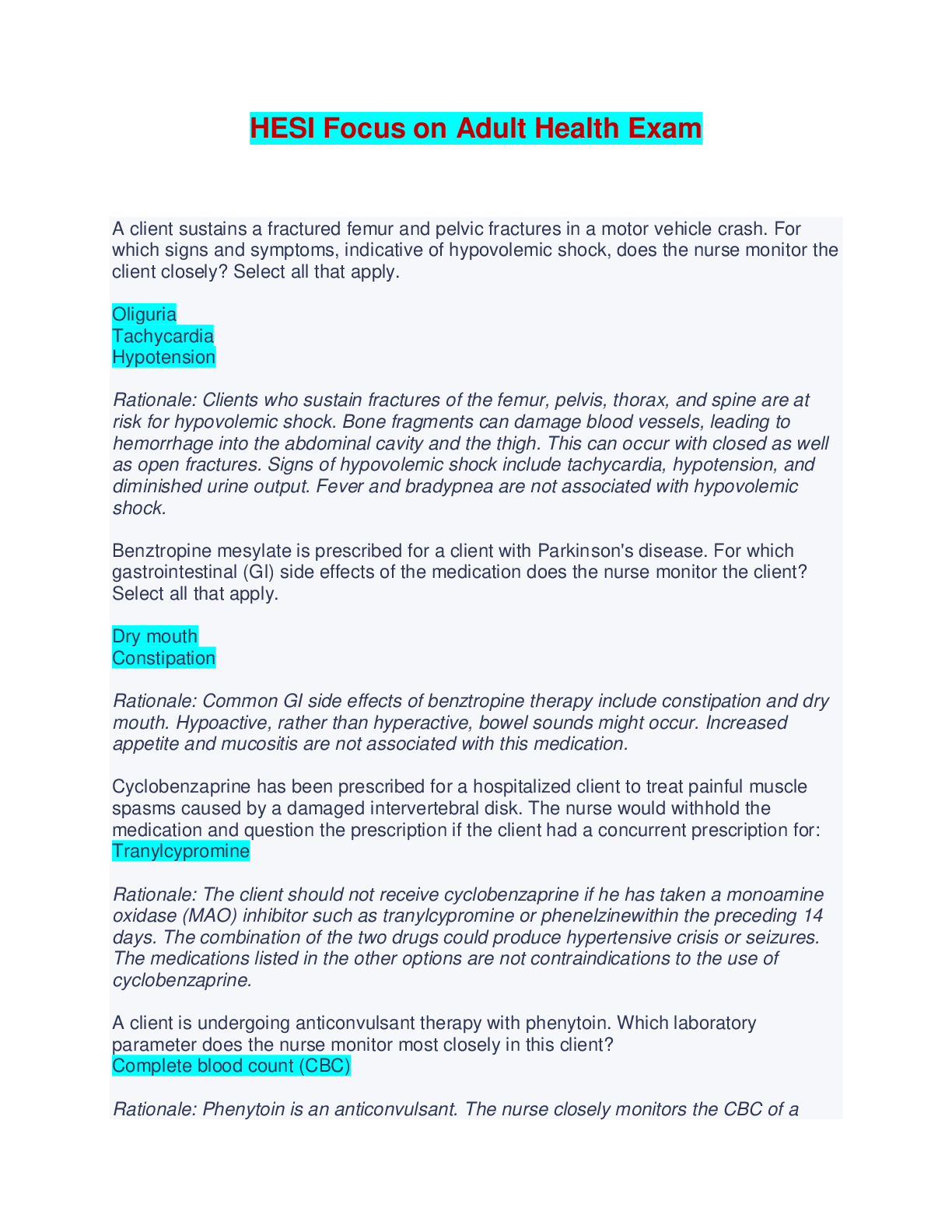HESI Final Exam - Question and Answers (Latest ) Grade A+///////
Document Content and Description Below
HESI Final Exam - Question and Answers HESI Final Exam 1. Which of the following signs would indicate to the FNP that a patient might have an airway occlusion and needs assistance? 2. Expected... objective findings in acute otitis media include: 3. Young adults may develop which kind of rash when they are infected with erythema infectiosum? 4. Which factor in a patient’s history places him at high risk for skin cancer? 5. Which of the following physical findings would be expected in a patient with peritoneal irritation? 6. At what age would the FNP expect to see a child use his or her pincher grasp? 7. An adolescent presents for a sports physical examination. He has a family history of premature cardiac death. He is nonsymptomatic and appears in good health. The FNP should use which technique during the examination to help determine the presence of abnormal heart sounds? 8. An FNP reviews both the patient log of a patient with type 2 diabetes and current lab results. Which findings indicate that the target value of the particular test is being met? 9. Which of the following actions best demonstrates that a 31-year-old woman has achieved the appropriate developmental task for her age group? 10. Which of the following comments by a patient with Osgood-Schlatter disease is consistent with the diagnosis? 11. In a patient with Bell’s palsy, which of the following physical exam findings is consistent with the diagnosis? 12. Which factor in the patient’s history should cause the FNP to suspect deep vein thrombosis? 13. Which of the following is not a trait found in a person suffering from PTSD? 14. Besides abdominal or flank pain, what would the best indicator be in a patient with a kidney stone? 15. Which of the following objective findings is pathognomonic for infectious mononucleosis? 16. What is the primary difference between tender points and trigger points as objective findings in a physical examination? 17. Visual acuity testing of a young man hoping to enter the military indicates 20/40 vision. The FNP interprets these findings to the man correctly as: 18. In assessing a patient suspected of having dementia, the FNP should assess whether the patient has difficulty in which of the following? 19. An FNP student sees a patient and reports finding annular lesions of 3 days’ duration. When you enter the room with the student, you expect to see skin lesions arranged in: 20. The FNP suspects that a 6-year-old child has been abused. Which finding would increase the index of suspicion for that diagnosis? 21. At what age would the FNP expect to see a child copy a circle? 22. After intense rectal itching, which of the following symptoms is most typical of pinworms in children? 23. Which of the following findings in a 70-year-old man would increase the suspicion of prostate cancer? 24. A patient is brought to the clinic with a nosebleed. Which of the following objective descriptions is consistent with a posterior nosebleed? 25. A college student presents to the College Clinic complaining of amenorrhea. Which factor in her history is least often associated with amenorrhea? 26. A patient comes to the office with complaints of wheezing. What associated history would best support a diagnosis of asthma? 27. Which of the screening techniques is most sensitive for risky drinking practices in pregnant women? 28. Which factor in the patient’s history should cause the FNP to suspect hyperlipidemia? 29. A mother brings her daughter for an eye evaluation. Which finding in the child’s history is most consistent with a diagnosis of amblyopia? 30. Which of the following best describes the expected physical exam findings in a patient with severe COPD? 31. Along with pharyngitis, which of the following would make the FNP least suspicious for group A beta-hemolytic strep? 32. Which of the following rashes is found in scarlet fever? 33. A review of a patient chart indicates that she has been on a very low calorie diet in an attempt to lose weight. For which serious complication should the woman be evaluated? 34. Which of the following elements in the history would make an elderly patient most susceptible to falling in the near future? 35. Which of the following historical factors in a patient with sickle cell disease typically is the presenting symptom of a patient in crisis? 36. A 17-year-old ballet student presents with concerns about not having a menstrual period in the past 3 months. She has been training especially rigorously for a special audition and has lost 13 pounds in the process. She is now 5’7” tall and weighs 105 pounds. The initial action by the FNP should be: 37. The use of 10% potassium hydroxide in wet mount slides assists in diagnosing: 38. A patient who has had a myocardial infarction and has an ejection fraction of 35% but is able to work full time and continues to attend exercise classes three times a week has which level of NYHA classification? 39. John Carlisle, a 65-year-old patient of the clinic, tells the FNP that he just had a nice retirement party. He has sold hardware for 40 years in the same family-owned store, which will now be closed. The NP asks what his future plans are. Which response would justify clarification, given the expected developmental task for this age group? 40. Which comment by an older woman would lead the FNP to include macular degeneration in a list of differential diagnoses? 41. Which patient is at least risk for a diagnosis of blepharitis? 42. A patient has been diagnosed with tennis elbow. This implies pain at what location? 43. Which of the following is not considered a risk factor for the development of cerebral palsy? 44. The FNP orders a CBC on a patient who presents with fatigue. Which of the following findings is indicative of macrocytic anemia? 45. The 7-year-old patient has a fever, along with URI symptoms. While assessing your patient’s throat and mouth, you observe blue-gray spots in the center of red eruptions. The most likely diagnosis for this patient is: 46. The FNP sees a 62-year-old man whose TSH level is low. Clinical findings include recent onset of palpitations, heat intolerance, and weight loss. Exam reveals heart rate of 116, mild diaphoresis, slight diffusely enlarged thyroid, and fine tremors of outstretched hands. Which additional lab test is appropriate? 47. A patient presents with hopelessness, irritability, and loss of concentration. Before making a diagnosis of depression it is important for the FNP to rule out which of the following? 48. Which finding is more suggestive of chronic fatigue syndrome than of fibromyalgia? 49. Which of the following symptoms of sinusitis is least likely to lead to a diagnosis? 50. When the FNP is discussing safety issues with the parents of a toddler, which of the following topics does not need to be addressed? 51. In which of the following patients would an atypical presentation of appendicitis be most likely? 52. A 21-year-old patient comes in with fever, malaise, and fatigue. Which of the following is the most likely diagnosis for this patient? 53. A 22-year-old woman has a 3-year history of recurrent, unilateral, pulsating headaches with vomiting and photophobia. The headaches, which generally last 3 hours, can be aborted by resting in a dark room. Usually she knows she is going to get a headache by the little squiggles she sees in front of her eyes. This presentation is most consistent with: 54. A 2-year-old child has a sudden onset of stridor. There is no history of a viral illness, fever, or vomiting. The child’s mother states that the child was well in the morning. What would be of highest suspicion on your differential diagnosis? 55. Which skin lesion necessitates immediate intervention? 56. A college freshman who learned the testicular examination procedure in a health class 2 days ago comes to the College Clinic “upset about my privates.” Further questioning elicits the following description: the testicle “feels like the candy called gummy worms.” The exam confirms that there is a palpable area in the left scrotum that is not pain. This most likely represents a diagnosis of: 57. A 7-year-old boy is brought in by his mother; there are molluscum contagiosum lesions in his genital area. This finding raises the index of suspicion about: 58. What subjective fact from a 14-year-old girl is most consistent with a diagnosis of a binge episode in bulimia? 59. A patient is complaining of having difficulty sleeping. He states that when he lies down he gets a feeling of having an electric current in his legs. This description is consistent with: 60. Which clinical finding is least diagnostic of ovulation for a couple attempting to use natural family planning? 61. Which of the following complaints, in addition to facial pain, is most indicative of TMJ disorder? 62. Which finding on a Tzanck smear confirms herpes? 63. Which of the following examination findings is consistent with the diagnosis of Hirschsprung’s disease? 64. A 19-year-old college student came in for an STD check. She had gone to a party where she had 6 12-oz beers and 2 shots of tequila in the first 4 hours. She is not sure how the party ended or how she got home. She is concerned she may have an alcohol problem. Which of the following screening tests would be the best to use in this situation? 65. Which of the following findings is the least suggestive that a terrorist attack has occurred? 66. When a patient complains of ear pain, the diagnoses of otitis media and otitis externa must be considered in the differential. In comparison with otitis media, otitis externa presents with: 67. A patient who has CHF and is taking an ACE inhibitor has noticed a dry, irritating cough. The FNP knows that the pathophysiology of the cough is: 68. A 23-year-old woman comes in with complaints of LLQ, pain, fatigue, and occasional spotting since her LMP, which was 8 weeks ago. The exam reveals closed cervical os, minimal blood in vaginal vault, uterus 8 week size, and fullness and tenderness of the left adnexa; right adnexa WNL; B/P 118/60; HR 94. Serum hCG is positive. What diagnostic test is appropriate and cost effective given these findings? 69. A 14-year-old girl is concerned about not having started her period. In looking over her records, the FNP notes that the patient is below the 5th percentile for height and weight and has a history of recurrent respiratory infections. Which differential diagnosis for the patient is least suspicious on the list? 70. Which of the following is not considered a tetanus prone wound? 71. A daughter brings in her 86-year-old mother with a concern about driving safety. Which of the following is not a concern for driving safety? 72. A 10-year-old girl, brought in by her grandmother whom she is visiting, has symptoms of a urinary tract infection. Which historical factor supports a diagnosis of cystitis? 73. A patient with possible osteoporosis should be treated based on which of the following DEXA test results? 74. A 54-year-old white male is being evaluated because he was found to have a low HGB (10.2) and HCT. He tells you that except for some fatigue and a 5- to 6-pound weight loss over the past 3 months he has not felt ill. You repeat the CBC and confirm that the patient has microcytic hypochromic anemia. You suspect iron deficiency. At this point, which of the following would be your best course of action? 75. Which of the following therapeutic interventions best addresses the underlying pathophysiological mechanisms of GERD? 76. A patient tells the FNP that she remembers having Braxton Hicks contractions with her first baby but also states, “These feel very different, and I am only 32 weeks pregnant.” Which response by the FNP would be best? 77. Which of the following patients should be referred to an ophthalmologist for treatment? 78. Which of the following children need a referral because of developmental concerns? 79. At what age would the FNP generally recommend that the parents start using a time-out system for discipline? 80. A man with type I diabetes asks the FNP what kind of exercises he can do. The patient had laser treatment of a partially detached retina 2 years earlier but his retinopathy is now stable. What exercise would be appropriate? 81. The FNP, after consultation with the collaborating physician, is going to start a patient with seizures on medication. Which of the following information is not true regarding women of childbearing age starting on antiepileptic drugs? 82. Which of the following is most helpful in terms of preventing allergic rhinitis? 83. A patient with asthma comes in for chest tightness. She is taking fluticasone (Flonase) and albuterol as directed and continues to have difficulty with coughing and wheezing. Her PEFR is 55% of predicted. Her medication regimen should be adjusted to include: 84. A patient has had a genital probe return with a positive Chlamydia but negative gonorrhea. The appropriate antibiotic treatment for this patient is: 85. Which of the following is an effective treatment for Ménière’s disease? 86. Which of the following is the second most prevalent bacterial pathogen in upper respiratory infections such as sinusitis? 87. Which of the following statements is true regarding the plan of care for ADHD? 88. Which drug best raises HDL cholesterol? 89. Which of the following is the best drug to order for rapidly escalating severe pain? 90. Which of the following medications is useful in reducing proteinuria and slowing the progression of chronic renal disease? 91. A female patient is diagnosed with blepharitis. What management, in addition to soaking the eyelids with a warm wet towel for 2 to 3 minutes, is appropriate? 92. A woman with known fibrocystic breast changes presents with complaints of tenderness and pain in her breasts. What plan of care is appropriate? 93. An elderly resident of a nursing home is referred to the clinic with a 2 cm ulcer on her left heel that is draining. The exam shows a cool, hairless left leg and a draining ulcer with a “punched out” appearance on the left heel. A popliteal pulse is not palpable. Which action by the FNP is best? 94. A high school girl is brought by her father to the clinic. She reports having a rash that started with a round patch on her left chest that has spread over her chest, arms, legs, and back and is itchy. The exam shows a generalized distribution of red, scaly, macular lesions that run parallel to each other. What action should the FNP take? 95. Education for a patient treated for a partial-thickness burn should include which of the following? 96. A patient is being seen for hypertension. Which of the following drugs is recommended for first line therapy? 97. An FNP is co-managing a teenaged girl with anorexia nervosa. Which treatment approach should be anticipated? 98. A patient has a history of migraine headaches for the past 2 years. The headaches have increased in frequency to 4 times a week. The FNP wants to start preventive therapy for the headaches. Which of the following is appropriate therapy? 99. An 11-year-old child’s last tetanus vaccination was given at age 5 upon entry to kindergarten. When should the child receive a tetanus booster? 100. A child has been diagnosed with Shigella and treated with ampicillin. The mother wants to know if there is anything that can be done to control the diarrhea. Which of the following actions is appropriate? 101. In which of the following conditions is emergency surgical treatment required? 102. A 48-year-old male presents with concerns about impotence. He is in a stable marital relationship and has no significant stressors at present. He has had hypertension for 2 years and is on a beta blocker. He has noted a gradual decreased interest in sex and confirms periodic headaches and lack of energy. He finds that his beard is less heavy than in the past. The exam reveals HR 72, BP 124/68, normal thyroid; testicles are slightly soft but normal size. What next step is warranted? 103. Which of the following should not be used on a regular basis for a patient with COPD? 104. A patient who is HIV+ has come back in to have a TB test read. Which of the following is considered a positive test for this patient? 105. A 29-year-old woman has a sudden onset of right-sided facial asymmetry. She is unable to close her right eyelid or frown or smile on the affected side. The rest of her exam is normal. Which of the following tests represents the best diagnostic test for the patient? 106. After attending a course on domestic violence, a group of FNPs sets out to modify their clinic into a setting more “safe feeling” for women experiencing partner abuse. Which modification is questionable in its capacity to promote a “safe haven” for abused female patients? 107. A 34-year-old woman is found to have a 2.5 cm non-tender breast mass on exam. She takes birth control pills. Follow-up after subsequent menses shows the mass is still present. Axillary nodes are non-palpable. Mammography reveals bilateral dense tissue in the breasts but no dominant mass. Which action by the FNP is most appropriate? 108. A woman has been fitted with a diaphragm and provided related education. Which comment indicates that she needs clarification about the diaphragm? 109. When should the adolescent female have her first Pap smear? 110. A patient with recently diagnosed CHF appears to have symptoms that are not currently controlled. The patient is taking HCTZ 25 mg and 5 mg of enalapril. Which of the following interventions is most appropriate at this time? 111. An FNP who volunteers in a women’s shelter notes the following behaviors in young girls who are living there with their mothers. Which would raise the index of suspicion of sexual abuse? 112. A patient who is being treated for tinea capitis is re-examined 2 weeks after oral antifungals without resolution of the lesions. The NP decides to continue the antifungals and re-evaluate in 2 more weeks. Which behavior by the parent indicates appropriate follow-up? 113. The FNP receives the ProTime and INR for a patient with atrial fibrillation. The patient takes warfarin 5 mg every day. The INR is 3.9. What is the appropriate adjustment of the warfarin dose at this time? 114. A patient who has a diagnosis of pneumonia returns to the clinic after not responding to antibiotic treatment after 48 hours. The patient has a respiratory rate of 36 breaths/minute. The FNP should do which of the following? 115. The following women are having mammograms today. For which one is the mammogram a screening test? 116. When the drawer test is performed on the knee, there is excessive movement of the knee on an anterior/posterior plane. The conclusion the FNP makes based on this data is: 117. A 19-year-old college student was diagnosed with bacterial meningitis. At this time the FNP should: 118. A patient has been seeing a counselor for her depression but does not feel that she has improved much. Based on the findings of research, the best addition to the patient’s plan of care would be to: 119. The FNP teaches a patient with SLE about avoidance of flares to extend remission. Which statement by the woman indicates that she has understood the advice? 120. Which of the following types of hearing loss is due to sensorineural hearing loss? 121. You are re-evaluating a patient who had iron deficiency anemia. What is the appropriate test to run in 3 to 5 days to determine whether her body is responding to the iron therapy? 122. Which of the following patients should be hospitalized for pertussis? 123. Actively pushing the patient to quit smoking before she is ready may have which of the following results? 124. A woman with PMS has received education about the condition and its management. Which comment shows that she has accurately understood the information? 125. After percutaneous exposure to an HBsAg-positive source, which of the following interventions is not appropriate? 126. In addition to dietary management, an exercise program, and behavioral therapy, the FNP prescribed sibutramine (Meridia) for an adult patient and provided comprehensive information about the drug. Which comment by the patient indicates a need for clarification? 127. The FNP is reviewing the chart of a new patient in advance of his visit. He has been diagnosed with BPH, and a review of the list of the current medications shows a significant list of drugs. Which drug, if on the list, would aggravate the prostate condition? 128. The FNP explains eye patching as a treatment strategy for a child with amblyopia related to strabismus. In a teach-back session, which comment made by the child’s father necessitates immediate clarification? 129. A woman with a history of spina bifida comes to the office for an annual Pap smear and checkup. Which of the following is important for the FNP to remember before beginning the exam? 130. Which of the following would be considered a “red flag” when treating an elderly patient complaining of abdominal pain? 131. A high school chemistry student is rushed into the ER with alkaline burns to both eyes after a lab accident. When a lawsuit is filed against the FNP, the risk manager reviews the chart for evidence of adherence to the standard of practice. Which action by the FNP, if documented in this chart, indicates a breach in the standard of care for this ophthalmologic emergency? 132. The FNP gives a presentation on skin cancer for a women’s group and explains the importance of using sunscreen with an SPF of 20. Which statement made by an audience member correctly explains the level of protection in SPF-20? 133. Which of the following findings is not an indication that the treatment prescribed for allergic rhinitis is successful? 134. The FNP prescribes radioactive iodine for a man with Graves’ disease and explains the treatment to him. Which explanation he provides later to his wife indicates that he understood the mechanism of action for the prescribed treatment? 135. A 73-year-old woman is asking the NP if the new shingles vaccine is applicable for her. The NP provides the following information: 136. Which of the following comments made by the patient indicates a need for further teaching concerning genital herpes? 137. Which comment by the patient indicates understanding of teaching for carpal tunnel syndrome? 138. The FNP provides instruction about pharmacologic treatment of aphthous ulcers. Which comment by the patient indicates a need for further instruction? 139. A woman with endometriosis is discussing her condition and its management with an FNP new to her case. Which comment indicates that her knowledge base is accurate? 140. Two of the most common side effects of drug therapy for Parkinson’s disease are which of the following? 141. After a student learns about hypothermia, which of the following comments by the student indicates understanding of the way most heat is lost from the body? When I am outside I should: 142. Which of the following factors would not influence the FNP to hospitalize a patient for treatment of pyelonephritis? 143. During a well-child check, the FNP finds a smooth philtrum and height/weight below 10%. The next step the FNP should take is: 144. Two nurse practitioners who work extensively with families with a city’s housing projects are developing a program called “Mom’s Night Out.” New mothers will come to the clinic for a healthy dinner, group support, and discussion of the changes associated with parenthood; babies are welcome. This project is an example of which kind of care? 145. A group of FNPs are working on their office privacy standards. Which concept can be excluded from the security plan? 146. A group of FNPs is developing clinical practice guidelines for a specialty practice with diabetic adolescents. Which fact about practice guidelines is inappropriate to guide their decisions? 147. There is a controversy in a large clinic: do patients wait longer to see the nurse practitioners or the physician providers? Staff members are hopeful that an answer will provide insight in changing the wait patterns. Which measure would be best to determine the answer to this question? 148. The FNP prescribes medications for an elderly patient with BPH whose drug coverage is in question because he has not applied for Medicare Part D. Which of the following facts is accurate about reimbursement of the patient’s medication cost? 149. The FNP is working with an adult woman with type 2 diabetes who is 60 pounds overweight; has high A1c, cholesterol, and triglyceride levels; and has had recent arthritic pain in both knees exacerbated by obesity. When the practitioner begins to discuss the need for weight management, the woman responds, “I realize my weight is contributing to poor health, but you just don’t understand. I am experiencing too much family stress to diet right now!” Which stage of the behavioral change theory does this reaction reveal? 150. An FNP student is discussing her plans for certification with an experienced clinical preceptor. Which comment by the student FNP deserves clarification by the experienced practitioner? [Show More]
Last updated: 1 year ago
Preview 1 out of 72 pages
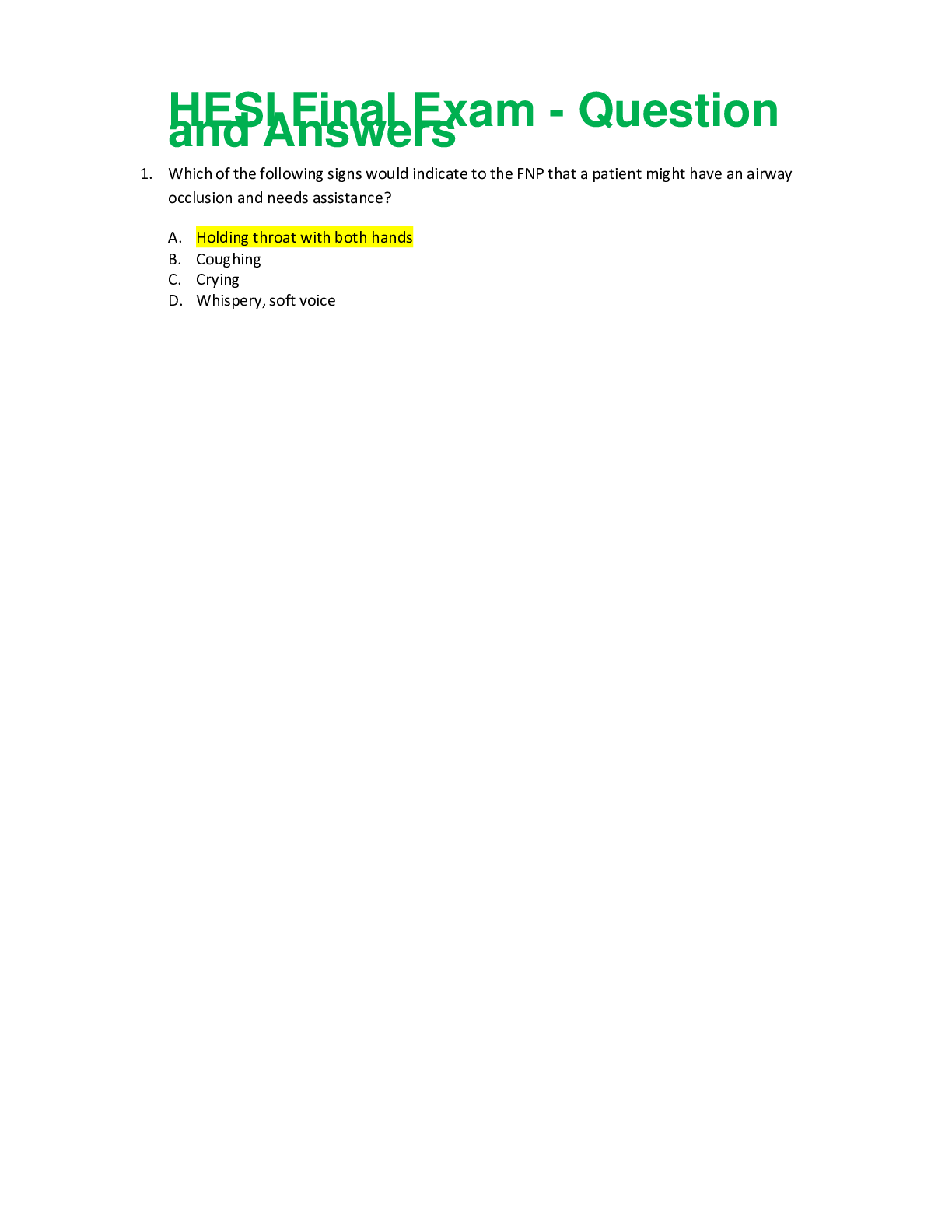
Reviews( 0 )
Document information
Connected school, study & course
About the document
Uploaded On
May 21, 2021
Number of pages
72
Written in
Additional information
This document has been written for:
Uploaded
May 21, 2021
Downloads
0
Views
55

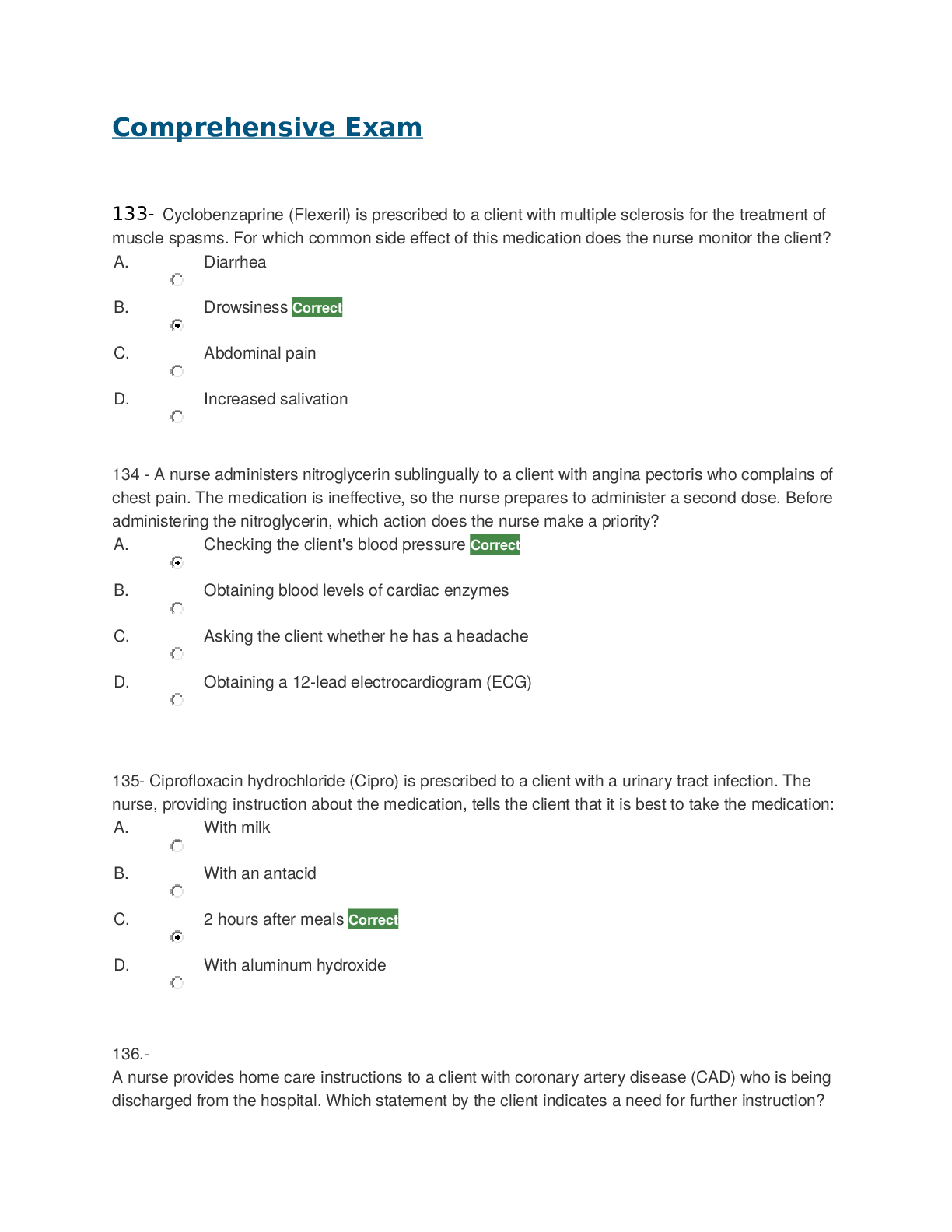
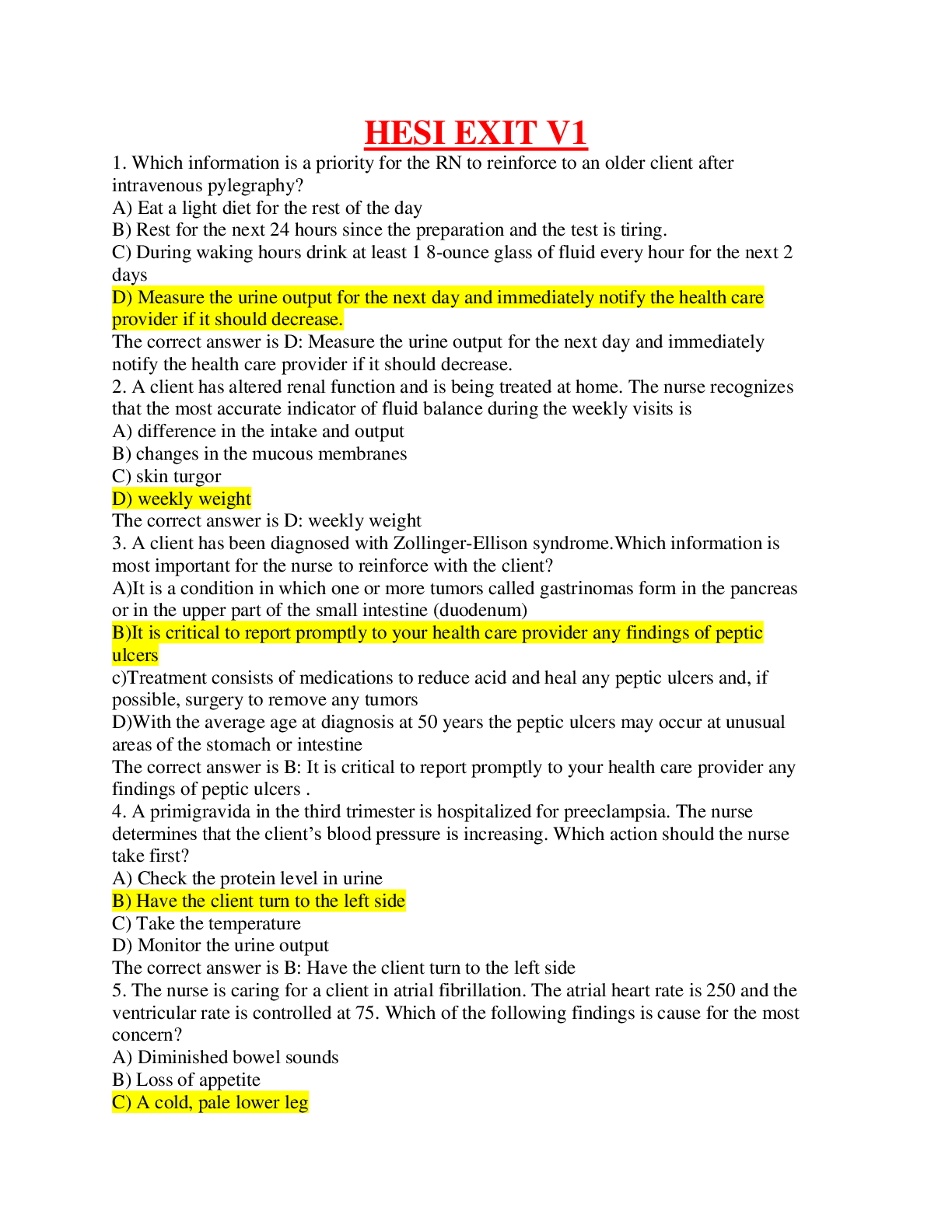

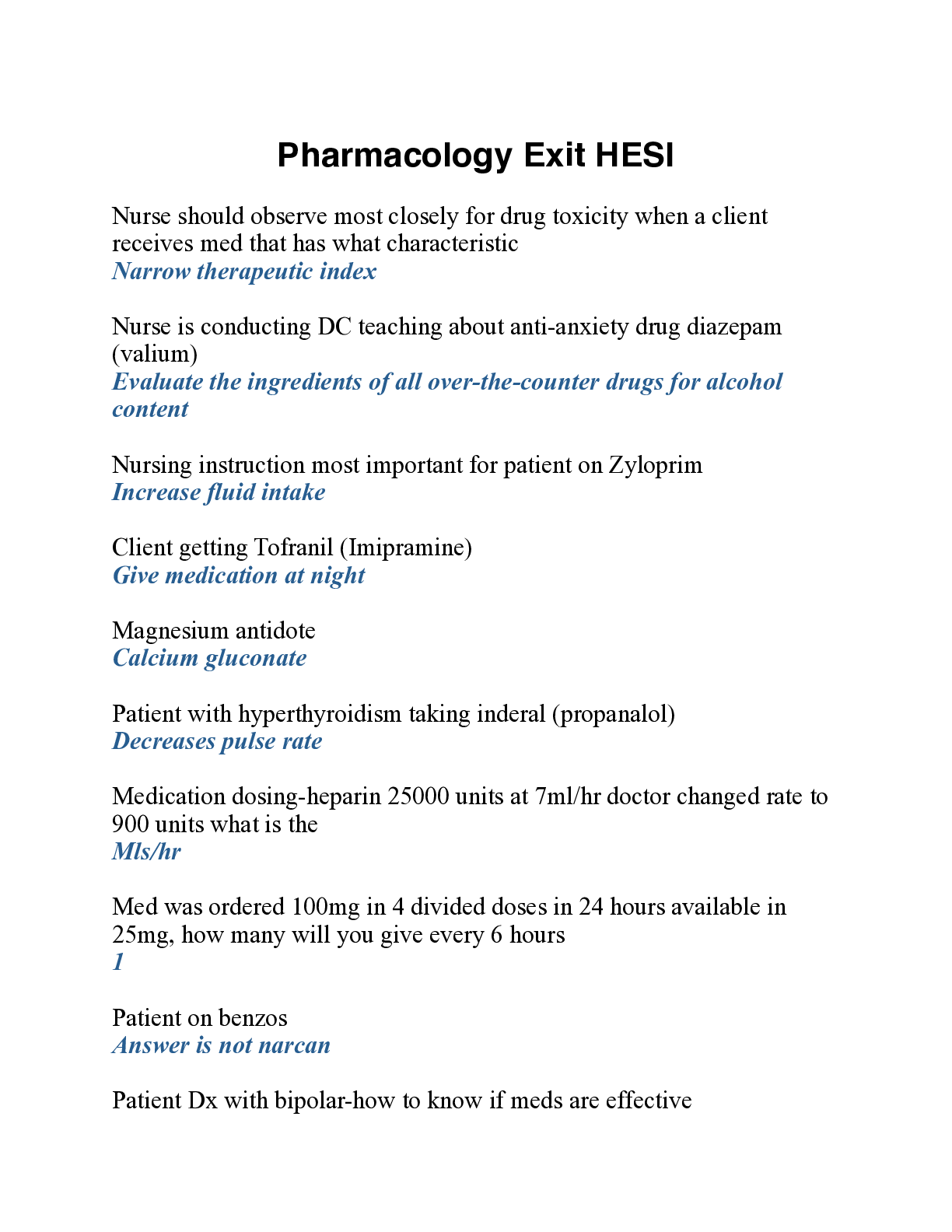
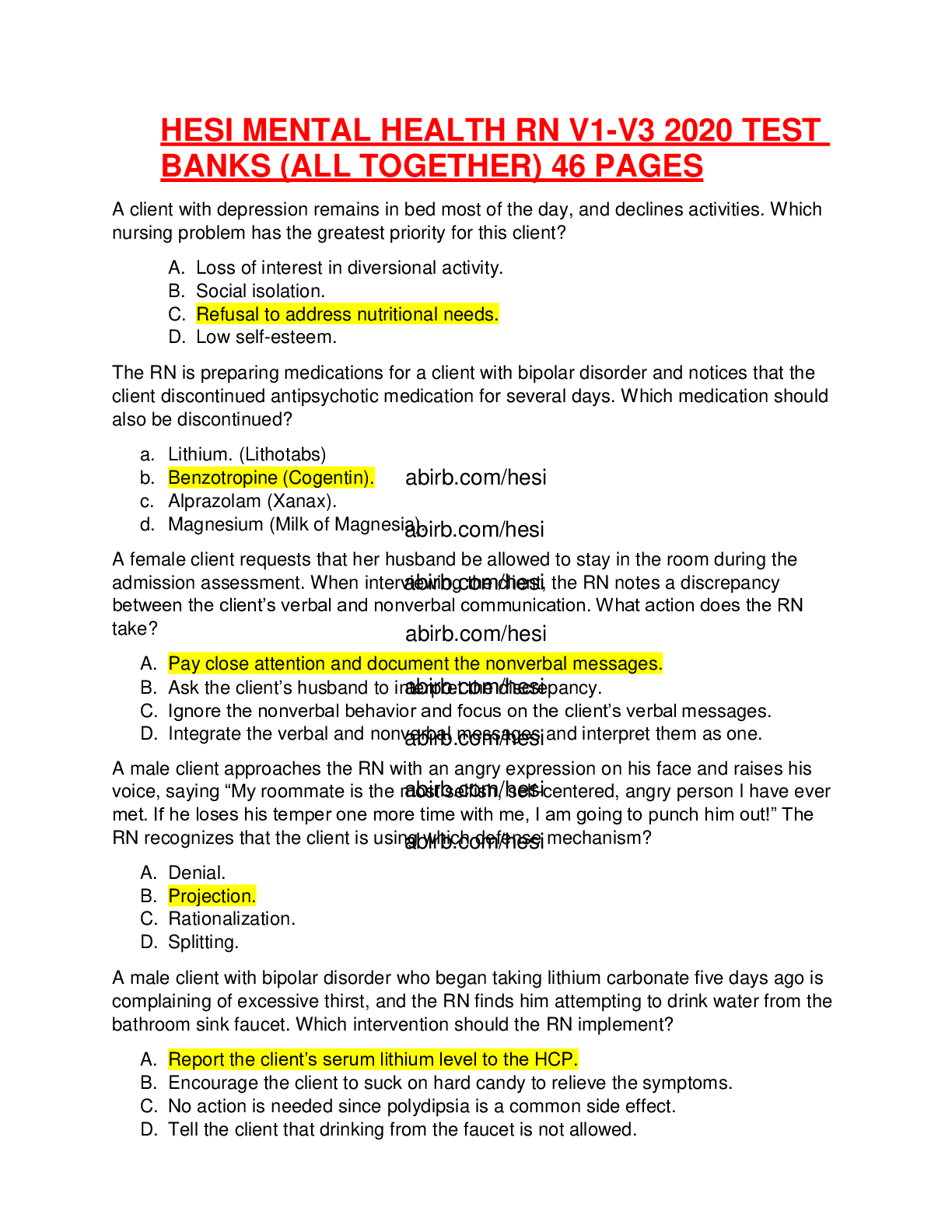
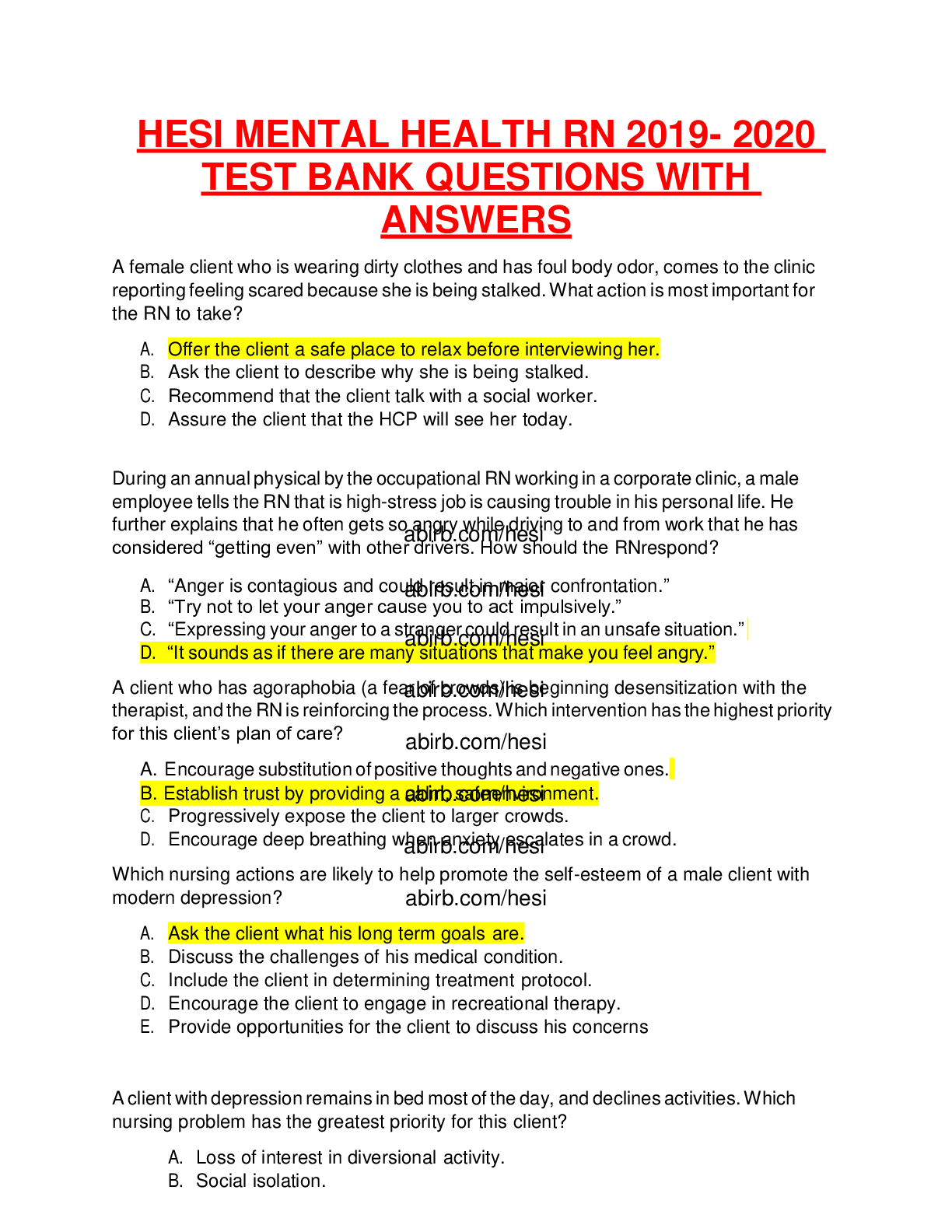
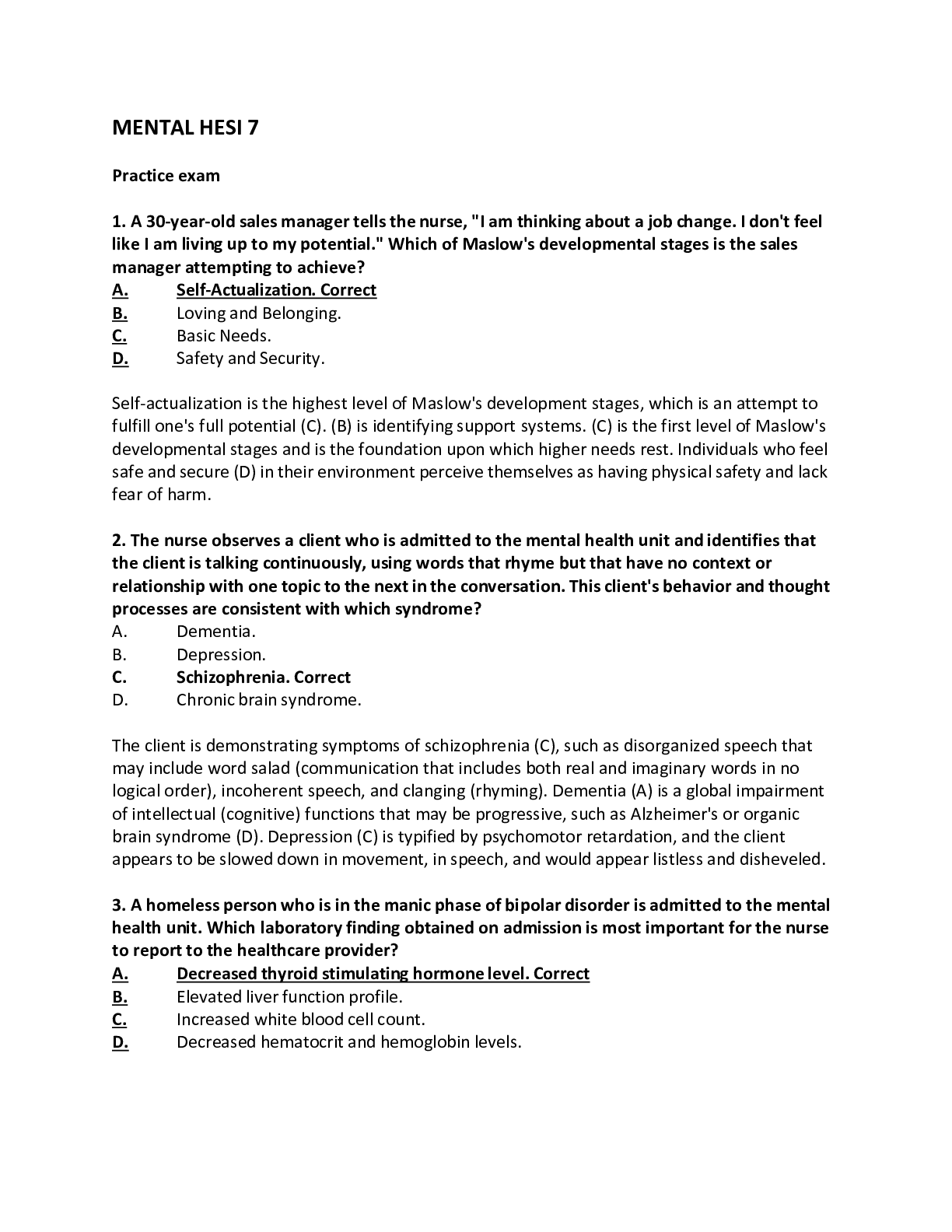




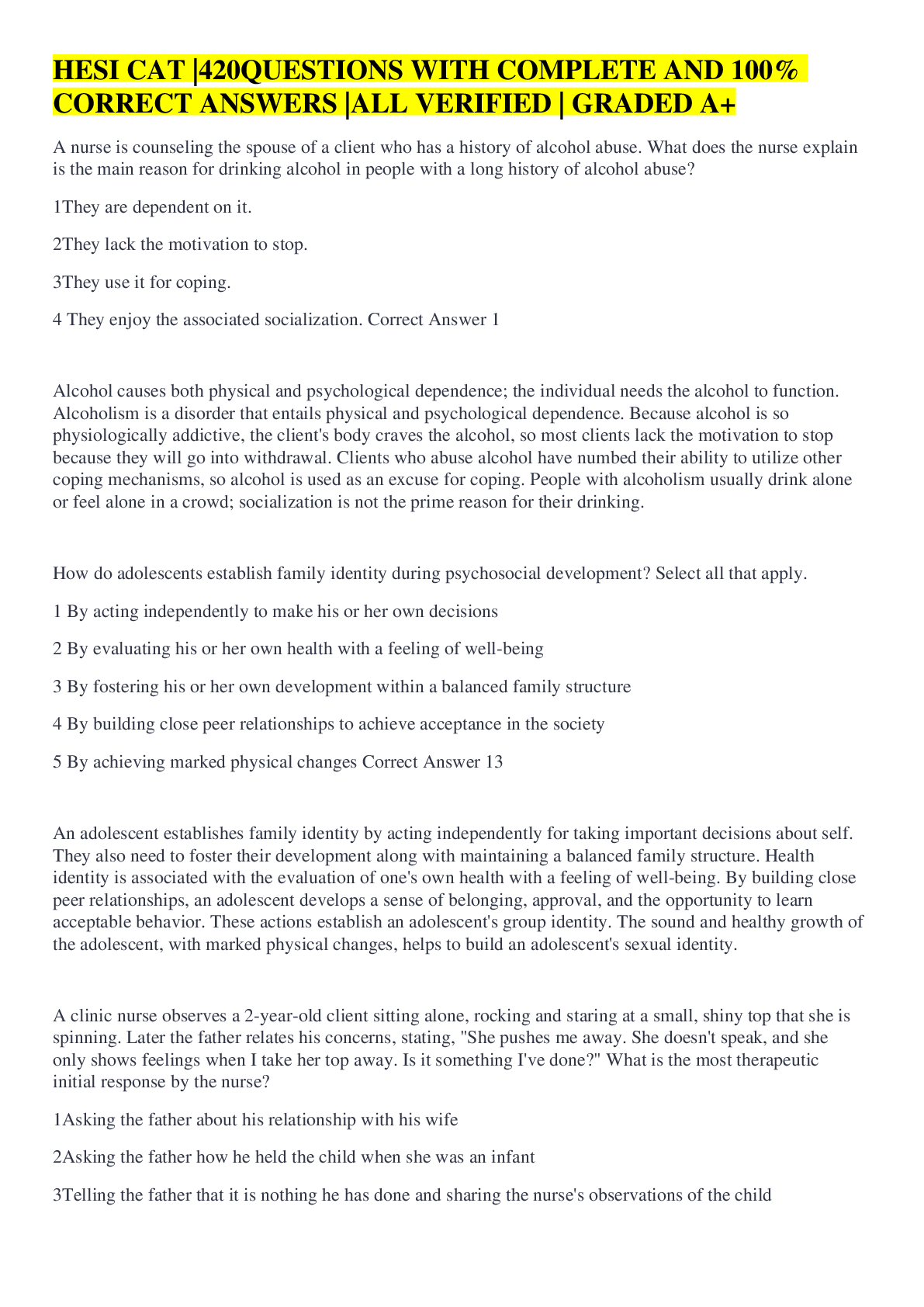
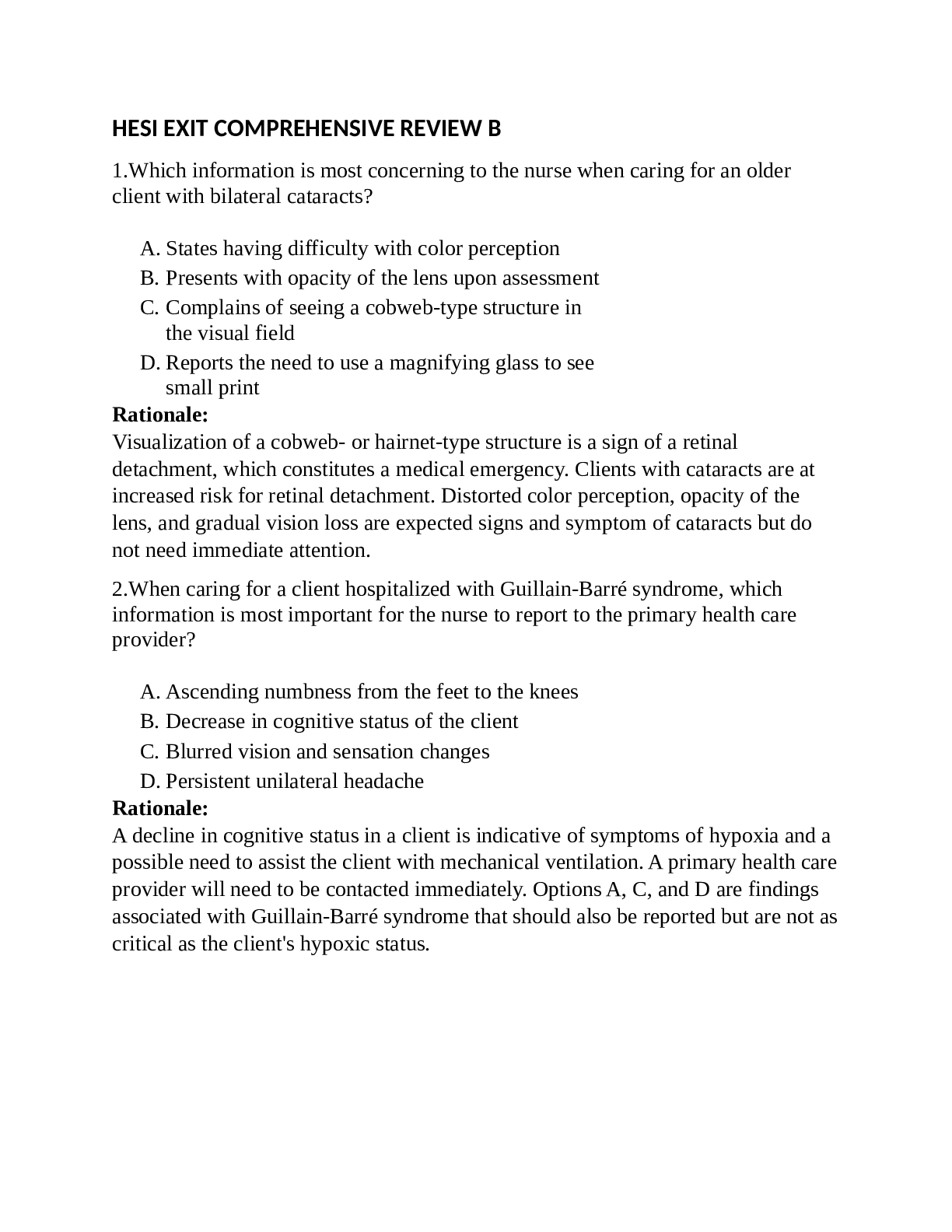
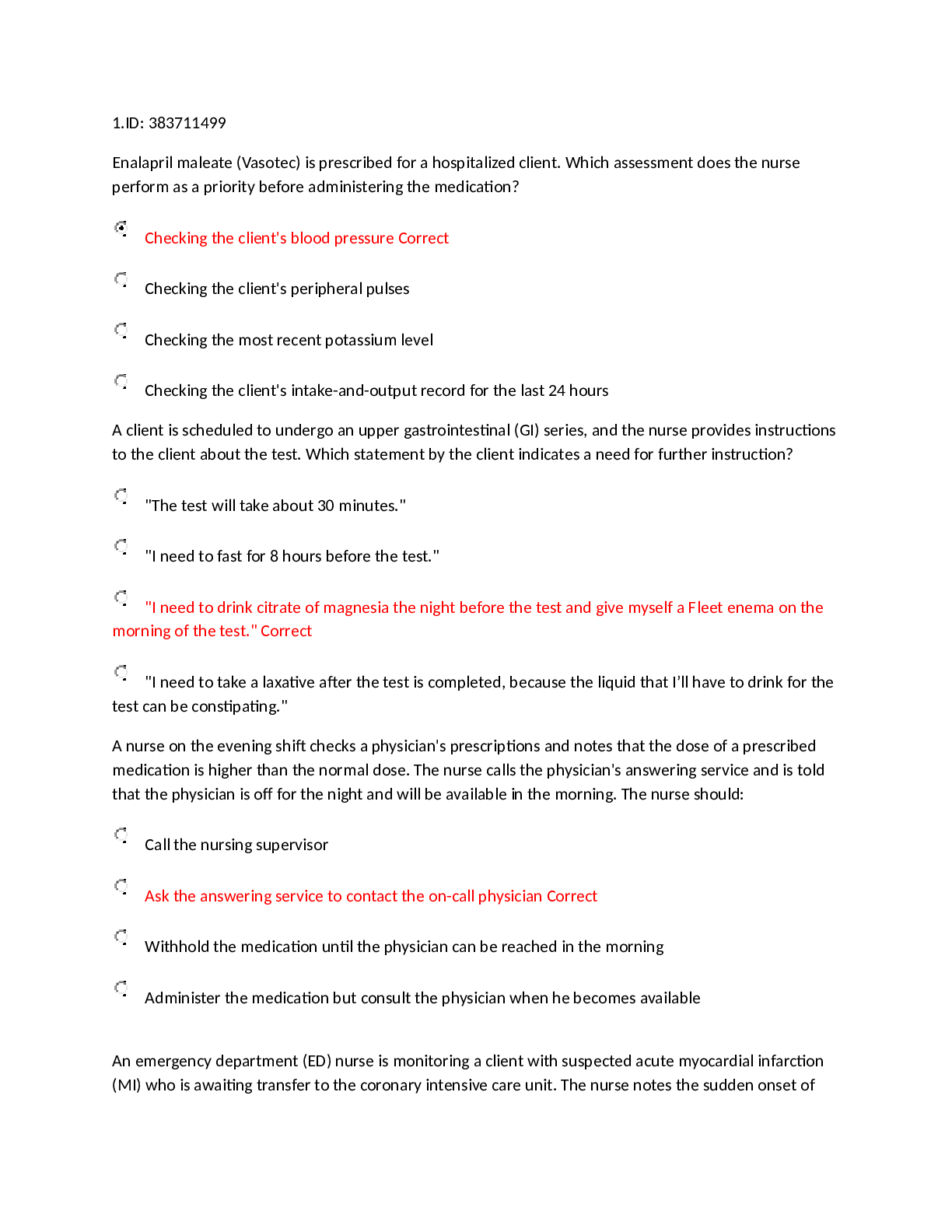



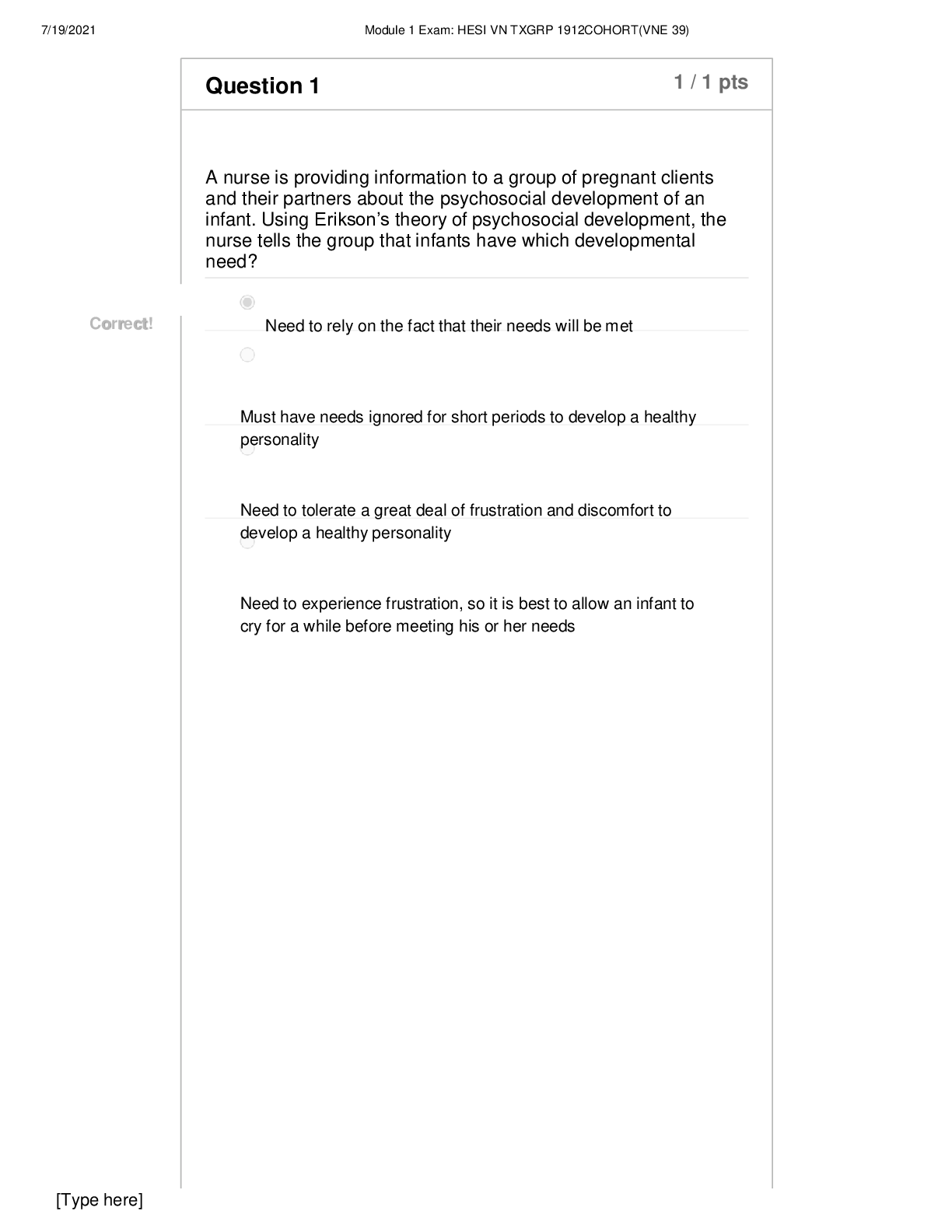
 (1).png)
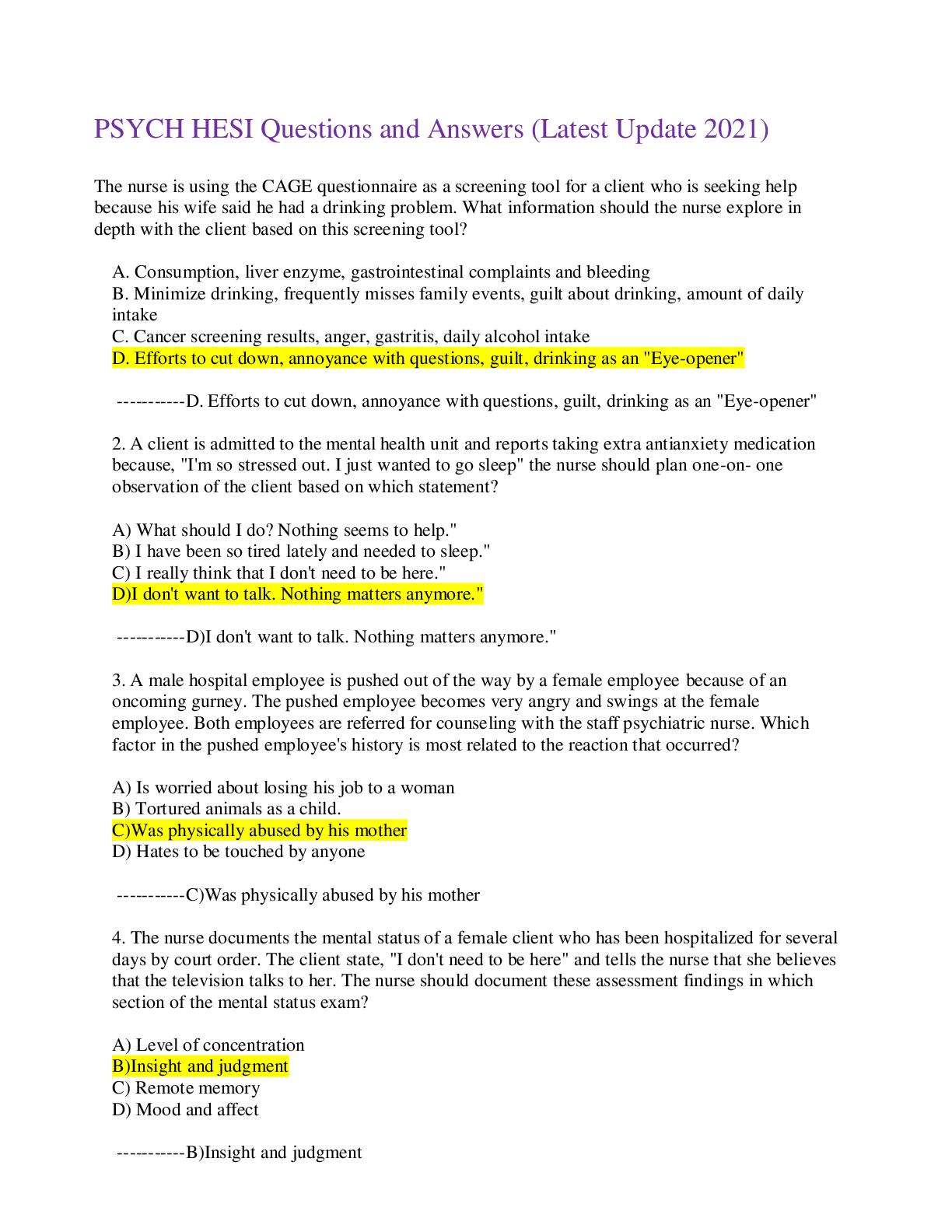
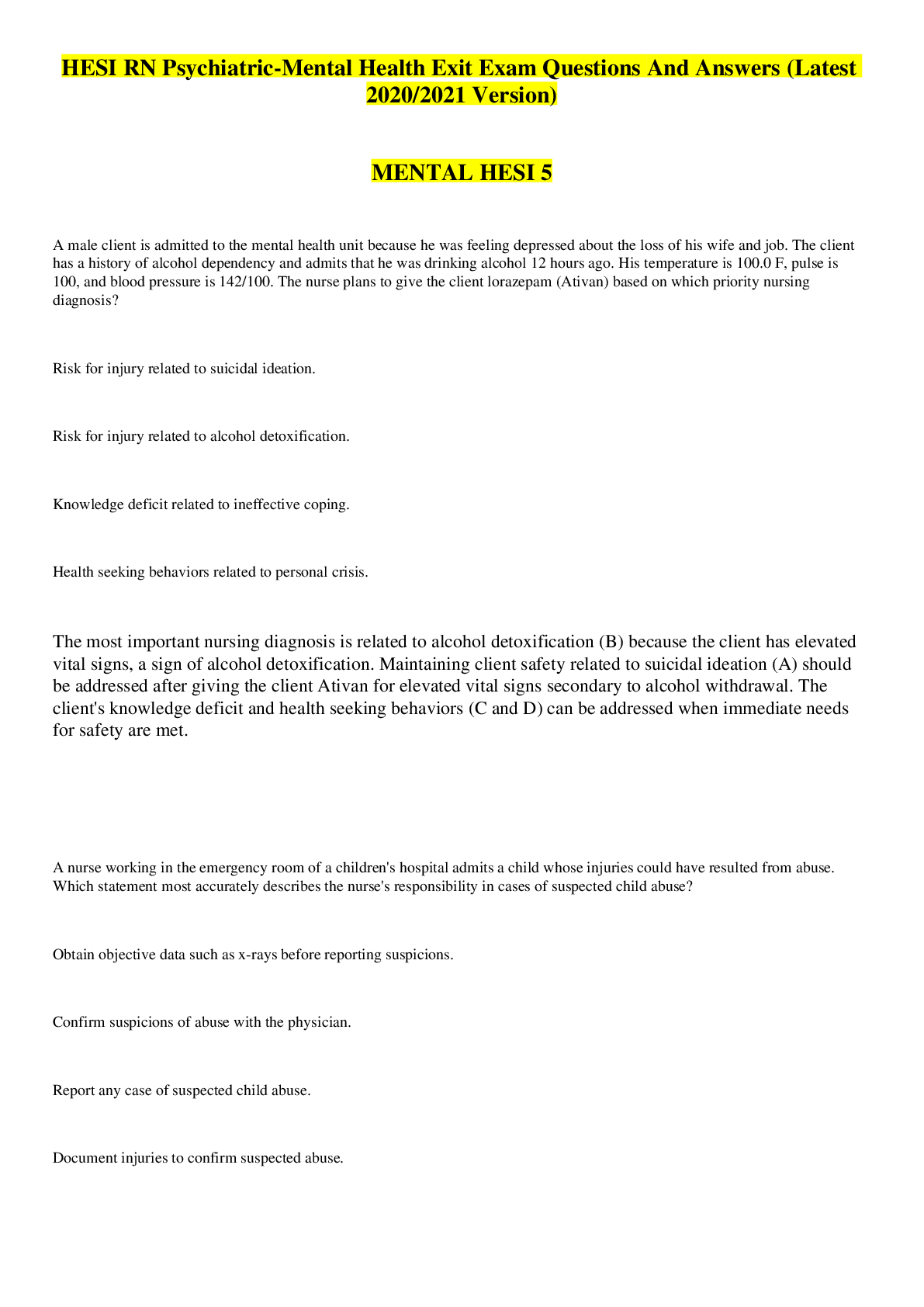
.png)


